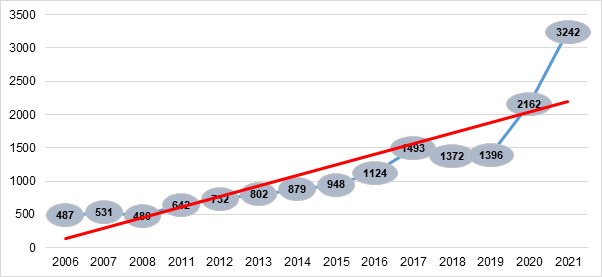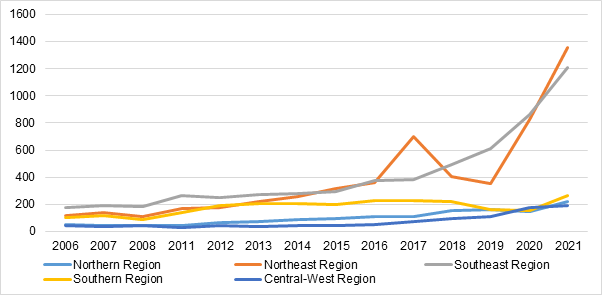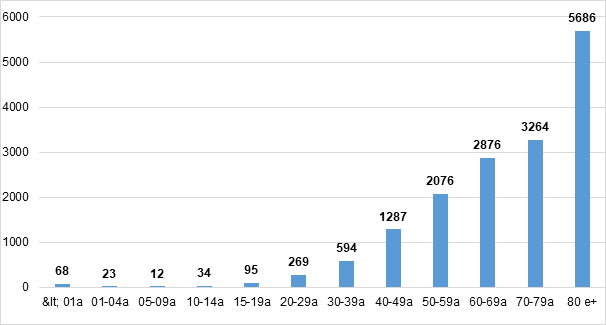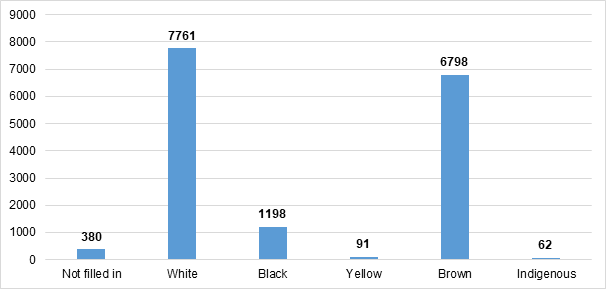MOJ
eISSN: 2379-6383


Research Article Volume 14 Issue 1
Federal University of Maranhão, Medicine Course, Pinheiro, Maranhão, Brazil
Correspondence: Consuelo Penha Castro Marques, Universidade Federal do Maranhão, Brasil, Tel (98) 99100-7752
Received: January 25, 2025 | Published: February 6, 2025
Citation: Marques CPC, Oliveira LV, Carvalho LC, et al. Occurrence of sudden cardiac death in Brazil from 2006 to 2021. MOJ Public Health. 2025;14(1):26-29. DOI: 10.15406/mojph.2025.14.00467
Sudden cardiac death is one of the main causes of death in Western countries, being responsible for the majority of deaths caused by cardiovascular diseases. In Brazil, even with the high prevalence of this event, there is a lack of studies on this topic. Based on this, and because it is an event of varied pathophysiology, this study aimed to offer scientific support on the epidemiological profile of this pathology in Brazil. A cross-sectional, quantitative, epidemiological, time series study was carried out between 2006 and 2021, collecting data from the SUS Information System (TABNET-DATASUS). These data were tabulated in an Excel spreadsheet and presented in graphs and tables. 16,290 sudden cardiac death events were observed in Brazil during the period analyzed. Regarding Brazilian regions, sudden cardiac death events were distributed as follows: Southeast = 5,856; Northeast= 5,505; South= 2,502; North= 1,421; Midwest= 1,006. As for age groups, those aged 80 and over were the most affected with 34% of events. Regarding race: white= 7,761; brown= 6,798; black= 1,198; yellow= 91; indigenous = 62; not filled in = 380. Regarding gender: male: 9,299; female= 6,989. Given this profile, the aim is to provide subsidies for managers, regarding the implementation of public policies that promote improvements in the prevention of sudden cardiac death, so that a reduction in these events can be achieved. Furthermore, the aim is to spread the discussion on the topic and contribute to academic knowledge in research on Sudden Cardiac Death (SCD), so that there is greater understanding of the pathophysiology, epidemiology and particularities of the event, generating better management of SCD, through public policy actions aimed at prevention.
Keywords: cardiovascular diseases, sudden cardiac death, epidemiology
Sudden cardiac death (SCD) is defined as that which occurs instantaneously or within 1 hour of the onset of symptoms, when the event is witnessed; or if not witnessed, it is an unexpected death from a cardiovascular cause in which the individual was seen alive in the last 24 hours.1 According to Sahium et al.,2 it is the most common lethal manifestation of heart disease and, in many cases, it is the first and only symptom.
The pathophysiology of this event involves several factors that can be categorized as cardiac, which are structural, functional or electrical; or non-cardiac such as pulmonary embolism, intracranial hypertension among other factors.3
SCD is one of the leading causes of death in Western countries and is responsible for the majority of deaths caused by cardiovascular diseases.4 According to Zaman, et al.,5 SCD is responsible for half of all cardiovascular deaths worldwide. Among the main causes of sudden cardiac death are coronary syndrome, cardiomyopathies (ischemic and non-ischemic), heart failure, atrial fibrillation, myocarditis or no defined cause.6,7
In a study in Europe, SCD was responsible for more than 13% of all deaths, and in around 50% of cases there was no previously detected cardiovascular disease, demonstrating the need to improve the diagnosis of heart disease.8 In Brazil, the same characteristic was observed in a study carried out in Ribeirão Preto, which showed that a slightly higher percentage, 20% of the sudden deaths analyzed, were defined as SCD.6
It can be said that this event can be avoided, since many of the diseases related to it are treatable. Furthermore, many of the sudden deaths may have been previously warned about through symptoms prior to the sudden fatal outcome, with symptoms not correctly interpreted or not even noticed.9
Given the possibility of prevention and the lack of more information on the epidemiology of this event, there is a need to study the epidemiology of sudden death in Brazil from 2006 to 2021.
This is an epidemiological, ecological, quantitative, descriptive study on the subject of the occurrence of sudden cardiac death in Brazil between 2006 and 2021. It was carried out by collecting secondary data from the SUS information system - TABNET - DATASUS, the official database of the Ministry of Health, through access to vital statistics, ICD-10: I 46.1.
The data was researched in the Mortality Information System - Deaths due to an unhelpful cause of death - sudden cardiac death described in this way - Sudden cardiac death described in this way - the variables collected are: year, sex, race/color, age group, federal unit of residence.
The data was imported from TABNET into Excel®, and organized into spreadsheets and graphs for descriptive statistics. The statistics were carried out using the Bioestat 5.3 program, which analyzed the descriptive statistics: mean, standard deviation and coefficient of variation, as well as presenting the data in absolute numbers and frequencies.
With regard to ethical criteria, Resolution No. 466 of December 12, 2012, exempted the Ethics Committee's opinion in cases of research using secondary data found in public databases. Therefore, since we used public and secondary data, our work did not require approval by the Ethics Committee.
In the period under study, there were 16,290 sudden cardiac death events in Brazil. The distribution of these deaths over the years revealed a growing trend, with a progressive increase in deaths from 2006 to 2017, a small decrease in 2018 and a substantial increase in 2020, with an even more significant increase in 2021. It was therefore observed that the years 2020 and 2021 exceeded the growing trend predicted for the period and show a large increase in deaths from this cause with a peak in 2021, as shown in Graph 1.

Graph 1 Distribution of sudden cardiac death in Brazil, from 2006 to 2021.
Source: Prepared by the authors, with data from the Ministry of Health/SVS - Mortality Information System - SIM, 2023.
The 2021 data, when compared directly to the 2006 data, represents a percentage increase of 665.70%. In terms of descriptive statistics, we found a mean of 1163.00 (±762.88) deaths and a coefficient of variation (CV)=65.56% between 2006 and 2021.
As can be seen in Graph 2, with regard to the Regions, there has been a greater increase in sudden deaths since 2019 in the Northeast and Southeast regions. It is also important to note that in the Northeast there was also a previous peak in 2017, surpassing all the other regions, while until 2016 it remained below the Southeast. Considering the total number of cases in each region, in terms of sudden cardiac deaths: Southeast region - n=5,856; Northeast region - n=5,505; South region - n=2,502; North region (1,421); Midwest region (1006).

Graph 2 Distribution of sudden cardiac death in Brazil, by region/year, from 2006 to 2021.
Source: Prepared by the authors, with data from the Ministry of Health/SVS - Mortality Information System - SIM, 2023.
As shown in Graph 2, the Northeast and Southeast are the regions with the highest number of sudden cardiac death events in Brazil. These figures can also be seen when analyzed individually by year.
As for sudden cardiac death events by region/year (Graph 2), it can be seen that between 2006 and 2014 the Southeast had the highest number of cases, being surpassed by the Northeast in 2015, which recorded 315 cases while the Southeast had 295 cases.
In 2016, the Southeast again took the lead with 378 cases, compared to 359 in the Northeast. The latter, in turn, saw a peak in cases in 2017, with 700 events reported, the highest single number so far of any region in the country. This figure was only surpassed in 2020, when the Northeast had 826 events and the Southeast 862. It is also worth mentioning that there was a fluctuation between these regions as to which had the highest number of cases in the year.
The Midwest and North, on the other hand, had the lowest number of SBCs. In the Midwest there was a bigger jump in occurrences between 2016, with 48 events, rising to 75 in 2017. This upward trend was observed in subsequent years. In the North, there was also an increase in the number of cases, but with a slightly more linear trend. This more linear trend of an increase in cases was also observed in the South of the country.
With regard to the measures of central tendency for each region: North: mean=101.5(±54.03) and CV=53.23%; Northeast: 393.21(±349.25) and CV=88.82%; Southeast: 418.29(±296.08) and CV=70.78%; South: 178.71(±52.97) and CV=29.64%; Midwest: 71.86(±52.45) and CV=72.99%.
Finally, it can be analyzed that in the year 2021, all regions presented their highest numbers of sudden cardiac death events.
As for the age group of sudden cardiac death events (Graph 3), the most affected was 80 years or more, accounting for 34% of events. In descending order: 70-79 years (20%); 60-69 years (17%); 50-59 years (12%); 40-49 years (8%); 30-39 years (3.6%); 20-29 years (1.7%); 15-19 years (0.6%); 10-14 years (0.2%); 5-9 years (0.07%); 1-4 years (0.14%); under 1 year (0.41%).

Graph 3 Distribution of sudden cardiac death in Brazil, by age group, from 2006 to 2021.
Source: Prepared by the authors, with data from the Ministry of Health/SVS - Mortality Information System - SIM, 2023.
With regard to declared race (Graph 4), there was a predominance of events among self-declared white and brown people. There was a slight majority of white people (7761) compared to brown people (6798), followed by black people (1198), yellow people (91) and indigenous people (62). It is also worth noting that there were a significant number of events, 380, which were not identified by race.

Graph 4 Distribution of sudden cardiac death in Brazil, by race, 2006.
Source: Prepared by the authors, with data from the Ministry of Health/SVS - Mortality Information System - SIM, 2023.
As for gender (Graph 5), there was a predominance of men (57%) over women (43%).
The findings of this study show that 16,290 sudden cardiac death events occurred in Brazil between 2006 and 2021.
Although there is a high prevalence of sudden death in the country, there is a scarcity of studies on the subject, its epidemiology and the groups most involved. It should be noted here that no scientific studies were found that compare the findings of this study not only to the number of sudden deaths in Brazil, but also to the variability of the distribution of these events over the period analyzed.
The lack of data on the subject is also reported by Braggion-Santos et al.,6 who reported that as far as they were aware, this was the first study to characterize various aspects related to sudden cardiac death.
Sahium et al.,2 carried out a study similar to our proposal, analyzing cases of sudden cardiac death in Brazil from 1996 to 2015. They reiterated that studies on this subject in Brazil are restricted and limited to select groups in specific locations, such as the study by Braggion-Santos et al.,6 which was carried out in Ribeirão Preto, and the study by Junior; Faria and Faria analyzed the epidemiological profile in the metropolitan region of Goiânia.10
Also according to Sahium et al.,2 they reported an estimated incidence of SBC in the São Paulo metropolitan region of 21,270 cases per year. The data from our study does not confirm the predictability reported by them since this figure exceeds all the events in the 16-year period analyzed throughout the country.
In our study, as mentioned above, the highest number of Sudden Cardiac Death (SCD) events was found in the Southeast and Northeast regions. The South was third, followed by the North and Midwest.
If we analyze the data in terms of the regions according to the years, all regions showed a high growth trend, which is in line with the study by Kumar et al.,4 which states that due to the continuous advance in the prevention, treatment and management of heart disease, the incidence of SCD will decrease. Contrary to this, Pannone et al.,7 and Wong et al.,1 show in their studies that even with great advances in the treatment and management of heart disease, sudden cardiac death still represents a social problem and has a high prevalence with a tendency to increase.
As for age group, the highest number of sudden cardiac deaths occurred in elderly people over 80 years old, according to the regional studies by Braggion-Santos et al.,6 and Junior; Faria; Faria.10 However, since the third decade of life, it can be seen that the incidence of events increases with age, as described by Sahium et al.2 Another important point that can be seen is that when children are analyzed, there is a higher number of incidences in children under 1 year old, a fact that can be explained by Sudden Infant Death Syndrome, reported by Nunes et al.11
With regard to race, the majority of sudden cardiac death events occurred in whites, followed by browns. Blacks were fewer, followed by yellows and indigenous people. It is also important to note that there was a significant number of events that were not reported by color. These data are in line with the study by Sahium et al.,2 which showed that the highest incidence was in black women and men, a fact that differs from our results. This analysis of events in relation to race shows conflicting results in several studies, as reported by Jazayeri and Emert in 2019.12–14
With regard to gender, a higher incidence was found in men, as in the regional studies by Braggion-Santos et al.,6 and Junior ASM, et al.10
Given the above, the study on the epidemiological profile of the occurrence of Sudden Cardiac Death (SCD) in Brazil requires further analysis and research in order to improve both the identification and intervention of events, as well as the implementation of public health policies aimed at reducing SCD, given the scarcity of studies on the subject in Brazil.
There is therefore a need for more studies into the investigation of sudden cardiac death, since even though it is one of the most important causes of death in Western countries, it is still poorly diagnosed and recognized by the majority of the population.
The data on sudden cardiac death to which we had access allowed us to identify the profile of occurrence of these events as white men, over 80 years old, mostly in the Southeast and with an upward trend over the period analyzed. It's worth remembering that even though this profile was the majority, we can't rule out the fact that the other variables analyzed were also of high epidemiological importance.
This data can support public policies that invest in better diagnosis, prevention and management of sudden cardiac death in Brazil. Research into this event provides gains for science and for the population as a whole, taking into account the foundation of epidemiological data that can better support the medical and academic communities.
None.
The authors declare there is no conflict of interest.
None.

©2025 Marques, et al. This is an open access article distributed under the terms of the, which permits unrestricted use, distribution, and build upon your work non-commercially.